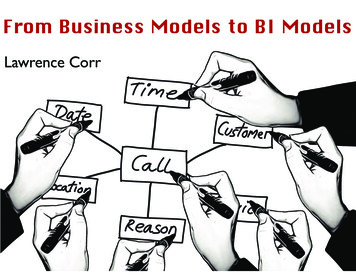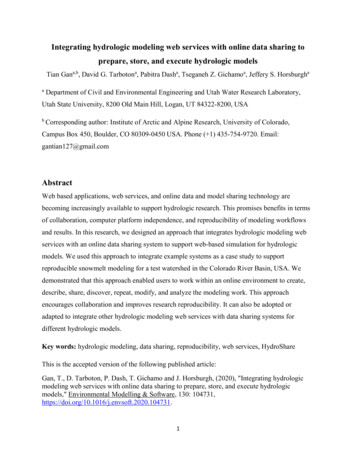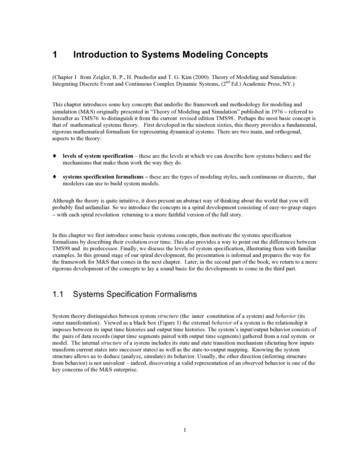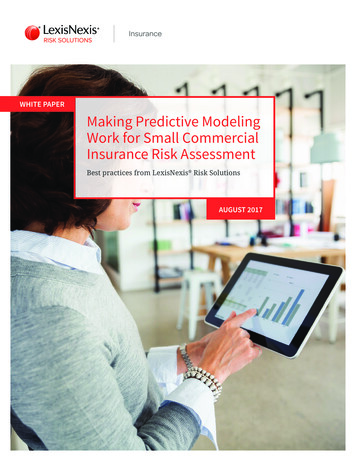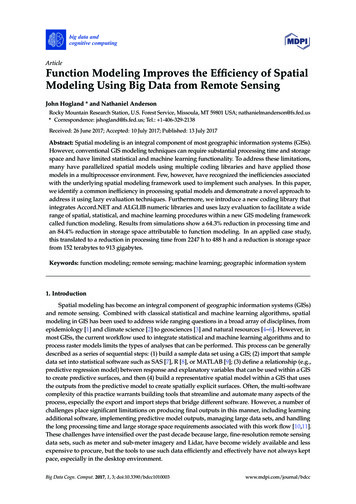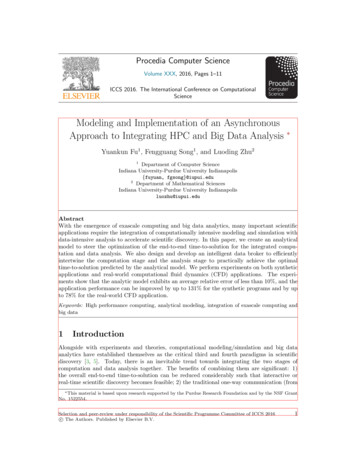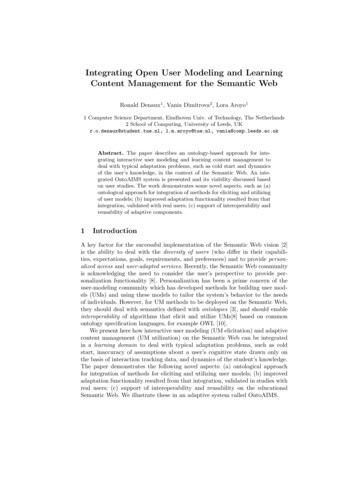
Transcription
Integrating Open User Modeling and LearningContent Management for the Semantic WebRonald Denaux1 , Vania Dimitrova2 , Lora Aroyo11 Computer Science Department, Eindhoven Univ. of Technology, The Netherlands2 School of Computing, University of Leeds, UKr.o.denaux@student.tue.nl, l.m.aroyo@tue.nl, vania@comp.leeds.ac.ukAbstract. The paper describes an ontology-based approach for integrating interactive user modeling and learning content management todeal with typical adaptation problems, such as cold start and dynamicsof the user’s knowledge, in the context of the Semantic Web. An integrated OntoAIMS system is presented and its viability discussed basedon user studies. The work demonstrates some novel aspects, such as (a)ontological approach for integration of methods for eliciting and utilizingof user models; (b) improved adaptation functionality resulted from thatintegration, validated with real users; (c) support of interoperability andreusability of adaptive components.1IntroductionA key factor for the successful implementation of the Semantic Web vision [2]is the ability to deal with the diversity of users (who differ in their capabilities, expectations, goals, requirements, and preferences) and to provide personalized access and user-adapted services. Recently, the Semantic Web communityis acknowledging the need to consider the user’s perspective to provide personalization functionality [8]. Personalization has been a prime concern of theuser-modeling community which has developed methods for building user models (UMs) and using these models to tailor the system’s behavior to the needsof individuals. However, for UM methods to be deployed on the Semantic Web,they should deal with semantics defined with ontologies [3], and should enableinteroperability of algorithms that elicit and utilize UMs[8] based on commonontology specification languages, for example OWL [10].We present here how interactive user modeling (UM elicitation) and adaptivecontent management (UM utilization) on the Semantic Web can be integratedin a learning domain to deal with typical adaptation problems, such as coldstart, inaccuracy of assumptions about a user’s cognitive state drawn only onthe basis of interaction tracking data, and dynamics of the student’s knowledge.The paper demonstrates the following novel aspects: (a) ontological approachfor integration of methods for eliciting and utilizing user models; (b) improvedadaptation functionality resulted from that integration, validated in studies withreal users; (c) support of interoperability and reusability on the educationalSemantic Web. We illustrate these in an adaptive system called OntoAIMS.
Our work on providing users with a structured way to search, browse andaccess large repositories of learning resources on the Semantic Web relates to research on adaptive Learning Content Management Systems (LCMS). Similarlyto existing LCMS, e.g. [4, 12], OntoAIMS employs student models to allocatetasks and resources for individual students. Distinctively, we use OWL ontologies to represent the domain and the UM. The latter extends the notion of adomain overlay by including students’ beliefs that are not necessarily in the system’s domain knowledge. In contrast with more general UMs for the Web, e.g.Hera [11], which consider merely user attributes, OntoAIMS uses an enhanced,interoperable, ontology-based user model built via a dialog with the user.The interactive user modeling component in OntoAIMS, called OWL-OLM,elicits an OWL-based open learner model built with the active user’s participation. This extends an interactive open learner modeling framework [7] to dealwith dynamic, ontology-based, advanced learner models [6]. Similarly to [9, 13],the open user modeling approach in OWL-OLM deals with a user’s conceptualstate. Distinctively, we exploit OWL-reasoning to maintain diagnostic interactions and to extract an enhanced user model represented in OWL. This shows anovel open user modeling approach that deals with important issues of modelingusers to enable personalization and adaptation for the Semantic Web.The focus of this paper is the integration and the benefits of both interactiveuser modeling and adaptive task recommendation. We first introduce the integrated architecture of OntoAIMS (Sect. 2) and then briefly describe its maincomponents: ontology-based user modeling (Sect. 3) and task recommendationand resource browsing (Sect. 4). Section 5 discusses how users accept the integrated environment. Finally, we conclude and sketch out future work.2Integrated OntoAIMS ArchitectureOntoAIMS1 is an Ontology-based version of the AIMS Adaptive InformationManagement System [1] providing an information searching and browsing environment that recommends to learners the most appropriate (for their currentknowledge) task to work on and aids them to explore domain concepts and readresources related to the task. Currently, OntoAIMS works in a Linux domain.OntoAIMS uses ontologies (see Fig. 1) to represent the aspects of the application semantics, to allow a strict separation of domain-dependent data, applicationrelated data and resources, and to further enable reusability and sharing of dataon the Semantic Web. The learning material is specified in terms of a ResourceModel that describes the documents in the resource repository and is linked tothe Domain Ontology which represents the domain concepts and their relationships. The course structure is represented as a hierarchy of tasks in a CourseTask Model. To enable adaptivity, OntoAIMS utilizes a User Model that coverslearner preferences, personal characteristics, goals and domain understanding.1The system is available with username visitor and password iewer.html.at
Fig. 1. OntoAIMS Integrated ArchitectureThe success of adaptation in OntoAIMS depends on the accuracy and completeness of the user model. Unobtrusive ways to collect user data have beenconsidered. The user’s interaction with the system (e.g. tasks/resources chosenand searches performed) is gathered in the Activity User Profile, which providesinformation about user preferences and personal characteristics. However, thisdata is insufficient for modeling a user’s domain understanding (called here conceptual state, see Sec. 3.1), moreover, such data is unavailable when the userlogs for a first time. Hence, to build a model of the user’s conceptual state, OntoAIMS employs an interactive UM component that maintains a dialog to elicita user’s conceptual model, see Sect. 3.2. Both the User Model and the CourseTask Model are used for recommending the learner a task to study, so that hecan navigate efficiently through the course structure, while the Resource Modelis used to allocate resources and rank them according to the appropriateness tothe learning task, see Sect. 4.3Ontology-based User Modeling in OntoAIMSThroughout the user interaction, information about concepts visited, searchesperformed, task status (current, started, finished, not started yet), resourcesopened, and bookmarks saved is stored in the Activity User Profile. It is usefulfor deducing user preferences and characteristics, and to make initial assumptionsabout the user’s domain understanding. To have an in-depth representation ofaspects of the user’s domain understanding, OntoAIMS uses a User’s ConceptualState. This section will outline how it is represented and maintained.3.1User’s Conceptual StateThe main reason for maintaining a conceptual state is to have an intermediatemodel that links a user’s conceptualization to an existing domain ontology. Theconceptual state is a model of the user’s conceptualization inferred during interactions with the user. To distinguish between a temporary, short-term statethat gives a snapshot of a user’s knowledge extracted during an interaction session and a long-term state that is built as a result of many interactions with
the system, we consider short term conceptual states (STCS) and a long termconceptual state (LTCS), respectively. The former is a partial representation ofsome aspects of a user’s conceptualization and is used as the basis for extractingthe latter that forms the User Model in OntoAIMS.STCS is defined as a triple of URIs pointing to a Conceptual model, a setof Domain ontologies and a LTCS. The Conceptual model is specified in OWL,which is well-suited for defining conceptualization and for reasoning upon it.The Conceptual Model resembles an ontology specification, i.e. it defines classes,individuals, and properties, and uses OWL properties to define relationships. Byusing OWL, concepts in the conceptual state are mapped to the domain ontology.Fig. 2 shows an extract from a conceptual model. The user has used theconcept Filesystem node2 12 times3 - 10 of these cases are supported by thedomain ontology and 2 are not. He has also stated 3 times that he knows theconcept Filesystem node and once that he does not know it. Fig. 2 also showsthat conceptual models keep track of specific relationships between concepts likeMove file operation being a subclass of the concept Command. Note that thelast relationship has been marked as used wrongly, which means that it is notsupported by the domain ontology and a mismatch between the user’s conceptualization and the domain ontology is indicated. Note also that a mismatchonly indicates that there is a discrepancy between the conceptual state and thedomain ontology, it does not indicate that the relationship is not true. rdf:Description rdf:about "blo:Filesystem node" rdfs:comment rdf:datatype "xmls:string" Any set of data that has a pathname on the filesystem. /rdfs:comment rdfs:label file /rdfs:label rdf:type rdf:resource "owl:Class"/ aimsUM:times used rdf:datatype "xmls:long" 12 /aimsUM:times used aimsUM:times used correctly rdf:datatype "xmls:long" 10 /aimsUM:times used correctly aimsUM:times used wrongly rdf:datatype "xmls:long" 2 /aimsUM:times used wronlgy aimsUM:times affirmed rdf:datatype "xmls:long" 3 /aimsUM:times affirmed aimsUM:times denied rdf:datatype "xmls:long" 1 /aimsUM:times denied /rdf:Description rdf:Description rdf:nodeID "A273" rdf:type rdf:resource "rdf:Statement"/ rdf:subject rdf:resource "blo:Move file operation"/ rdf:predicate rdf:resource "rdfs:subClassOf"/ rdf:object rdf:resource "blo:Command"/ aimsUM:times used rdf:datatype "xmls:long" 1 /aimsUM:times used aimsUM:times used wrongly rdf:datatype "xmls:long" 1 /aimsUM:times used wrongly /rdf:Description Fig. 2. An extract from a student’s Conceptual Model based on a dialog episodefrom the second study described in Sect. 523This concept is defined in the domain ontology, which can be found athttp://wwwis.win.tue.nl/ swale/bloThe RDF specification of the properties used to annotate conceptual states can befound at http://wwwis.win.tue.nl/ swale/aimsUM
STCS is used to update LTCS which associates a belief value for each domainconcept. The belief value is calculated based on the conceptual model. The firsttime the concept is used its belief value is assigned to 50 (out of 100). From thenon, Belief value(c) x (100 x)/2, if there is evidence for knowing c andBelief value(c) x/2, if there is evidence for not knowing c, where x is thecurrent belief value of c and evidence is calculated depending on the situation,e.g. times used correctly/times used.3.2Dialog for Extracting a User’s Conceptual ModelOntoAIMS uses OWL-OLM – an OWL-based framework for Open LearnerModeling to (a) validate the analysis of the user data, (b) elicit a learner’sconceptual model, and (c) build and maintain a dynamic UM. OWL-OLM follows the STyLE-OLM framework for interactive open learner modeling [7] butamends it to work with a domain ontology and user model built in OWL. OWLOLM builds a conceptual model of a user by interacting with him in a graphicalmanner (see Fig. 3). During these interactions, both OWL-OLM and the usercan ask domain-related questions and give their opinions about domain-relatedsentences. To maintain the dialog, OWL-OLM uses a discourse model and infersknowledge from the domain ontology and from the current conceptual model.Because OWL is used as the representation language, OWL-OLM can deployexisting OWL reasoners for the Semantic Web, currently, it uses Jena 4 .The OWL-OLM screenshot in Fig. 3 shows the dialog history in the upper-leftcorner and the last utterance in the graphical area.The user composes utterances by constructing diagrams using basic graphical operations – ’create’,’delete’ or ’edit’ a concept or a relation betweenconcepts – and selectinga sentence opener to define his intention, e.g. to’answer’, ’question’, ’agree’,’disagree’, ’suggest topic’.For a detailed description ofOWL-OLM see [6, 5].OWL-OLM analyzes eachFig. 3. Graphical User Interface of OWL-OLMuser utterance to determinehow to update the user’sconceptual model based on4http://jena.sourceforge.net/
the domain concepts and relations used in the utterance. It determines whetherthe user’s statement is supported by the domain ontology, and, if this is not thecase, marks a mismatch. Reasoning over the domain ontology and the conceptual model is also used to determine how OWL-OLM continues the dialog, e.g.asking the user a question, initiating a clarification dialog to discuss a mismatch,or answering a user’s question.Currently, OntoAIMS calls OWL-OLM to probe about a user’s domain understanding, and, based on the task model, specifies what domain aspects haveto be discussed. The dialog can be terminated either by the user whenever hewishes or by OWL-OLM when the required aspects of the user’s conceptualization have been covered. OWL-OLM then uses the extracted STCS to update thebelief values in the LTCS that is used by the task recommendation in OntoAIMS.4Task Recommendation and Resource BrowsingThe OntoAIMS Course Task Model consists of a hierarchy of tasks. An exampleextract from a simplified representation of the Course Task Model used in thecurrent instantiation of OntoAIMS is given below.Course: Introduction to LinuxT1. IntroductionT1.1 Operating SystemsT1.1.1 Definition and Description; concepts {operating system, kernel, system program,.}.T1.2 Files and FilesystemsT1.2.1 Files and operations on files; concepts {file, filename, copy files, view files,.}.T4. The Gnome environmentEach course task T is represented as (TID , Tin , Tout , Tconcepts , Tpre ), whereTin is the input from the user’s Activity Profile, Tout is the output for the user’sActivity Profile and for STCS based on the user’s work in T, Tconcepts is a setof domain concepts studied in T, and Tpre indicates the prerequisites for T (e.g.knowledge level for each Tconcept , other tasks and resources required).The task recommendation algorithm first selects a set of potential tasks torecommend from all tasks in the Course Task Model, by checking whether theirTin and Tpre are supported by the Activity Profile and the belief values for theconcepts in LTCS. OntoAIMS checks the concept knowledge threshold for theconcepts in Tconcepts and recommends either to follow the task if the knowledgeis not sufficient or to skip the task otherwise.When the user chooses to perform the recommended task, the OntoAIMSResource Browser (see Fig. 4) helps the user to learn more about the domainconcepts related to that task. He can search for and read learning resources,browse domain concepts and study their definitions in the context of this task.For each resource in the search result list OntoAIMS provides two types ofranking - relevancy to the current task, and relevancy to the current user query.In this way, OntoAIMS can recommend resources for those concepts the userdoes not know or which contain mismatches with the domain ontology. Theuser’s activities for a task and Tout are used to update the user model once the
Fig. 4. OntoAIMS resource browsertask is completed. It is possible to employ OWL-OLM to validate the updatesto the Conceptual State in Tout , although this is not currently implemented.5Initial Evaluation of OntoAIMS with UsersWe have conducted user studies with OntoAIMS to: (a) verify the functionality ofits components (user modeling, task recommendation, and resource browser); (b)examine how users accept the integrated environment and its adaptive behavior;(c) identify how the system can be improved with additional adaptive features.5.1Observational studiesTwo user studies were conducted with the current instantiation of OntoAIMSin a domain of Linux. Initially, six users, postgraduate students and staff fromthe universities of Leeds and Eindhoven, took part. An improved version of thesystem was used in a second study with ten first year Computing undergraduatesat Leeds. It followed a two-week introductory course on Linux. In both studies,the users attended individual sessions, which lasted about an hour and werevideo recorded and monitored by an observer. OntoAIMS did not have dataabout the users prior to their logon to ensure realistic cold start conditions. Theusers were asked to study resources on Linux, which would be recommended bythe system. At times, the observer interrupted the users to clarify their behaviorwith the system. At the end, the users were given a questionnaire related to theirsatisfaction and suggestions for system improvements.
5.2Results and DiscussionWe will discuss here the benefits of the integrated architecture, see [5] for moredetails about the OntoAIMS evaluation. OntoAIMS was regarded as helpful forboth tuning one’s knowledge in Linux and learning more about domain concepts.Every user appreciated the integrated functionality and worked with all components. Because at the start the system did not have any information about theusers, it directed them to OWL-OLM (see Sect. 3.2), where users spent abouthalf an hour on average. OWL-OLM probed their domain knowledge followingthe topics defined in the task ontology. Based on the dialog, the users were suggested tasks suitable for their level (see Sect. 4). They then spent about halfan hour with the resource browser (see Sect. 4) exploring domain concepts andreading resources offered by the system.Benefits from OWL-OLM The evaluation showed strong potential of OWLOLM to deal with the cold start problem. OWL-OLM assessed the students’ levelof expertise and recommended them appropriate tasks to study. The expert usersfollowed the OWL-OLM dialog answering most questions, and occasionally askedthe system to confirm their domain statements. These users were pleased to beable to show their familiarity and to engage in discussions on more advanceddomain topics. Less knowledgeable users struggled to answer the system’s questions and often sought the answer from OWL-OLM. These users explored avariety of dialog moves, e.g. they disagreed with system’s statements, composednew concepts and links, and asked several types of questions. There were occasions when discrepancies with the domain ontology were shown, which triggeredcorresponding clarification dialog games.OWL-OLM was regarded by all users as a component that helped them learn.The students used the dialog to study about the domain and commented thatthe OWL-OLM dialog made them think about their knowledge, so they becameaware of which concepts they were familiar with or struggling with. Indeed, asreported in [7], interactive open user modeling provides the means for reflection.Benefits from task recommendation The user models generated with OWLOLM were used to inform the task proposal. Some users were offered to skiptasks, as OWL-OLM found that they already knew quite a bit about that topic,while less knowledgeable users were directed to introductory topics. Most usersagreed that the task recommended by the system was appropriate for their level,two students disagreed with this as they found the resources insufficient for therecommended topics. All users were pleased that the system could recommendthem a task, they followed the recommended tasks, and regarded them as compliant with their learning goals. All users but one, said that they were aware whythe task recommendation was made, which was due to the preceding OWL-OLMinteractions. This gives a strong argument for the benefits of integartion.Benefits from resource browsing The resource browser was regarded as “aflexible way of looking at resources”. The users found it intuitive and easy to
use. All users agreed that the graphical representation gave them an overviewof the conceptual space: “it allows to map your path through sequences of topics”, “demonstrated exactly where I was in relation to the suggested topic”. Theusers were offered a set of resources ranked according to their appropriatenessto the task. Depending on the goal (e.g. learning more about a concept, checking the syntax of a command, or tuning the student’s domain knowledge), theresources the students were looking for differed in size, structure, and depth ofdomain knowledge. All users were pleased to see document ranking, but, againall of them, wanted this to be done not according to the the task but the user’spreferences, knowledge, and current goal. This points at the need for furtherimprovement of the integration, as discussed below.Table 1. Additional adaptive features in OntoAIMS as pointed out by the ten usersin the second study (the numbers show how many students support the feature).FeatureNoI want the resources ranked according to my preferences and knowledge10I want the resources ordered according to my preferences and knowledge8I want the resources filtered according to my preferences and knowledge4I would like to be able to choose when the system should be adaptive10I would like to know what the system’s thinks about my knowledge10I would like to know how my interaction with the system is used to formthe system’s opinion about my knowledge8I would like to know how the system’s behavior is affected by its opinion about me 9I would like to be able to inspect and change what the system thinks of me10Improving the integration and adaptation The evaluation pointed at improvements needed with regard to the integration between OWL-OLM and theresource browser. All students wanted to use a flexible switch between bothmodes. They stressed that this should be the user’s choice, not something imposed by the system, and pointed at ways to implement it, e.g. offering the usersa choice to go to the resource browser when they ask a question in OWL-OLM orenabling them go to a dialog to check their domain understanding after readingresources in the browser. The users in the second study were asked about additional adaptive features. The study pointed at future extensions of OntoAIMSto further integrate OWL-OLM and resource recommendation, see Table 1.6Conclusions and Future WorkThe paper proposed an ontology-based approach for integrating interactive usermodeling and learning content management to deal with typical adaptation problems on the Semantic Web, such as cold start, unreliability of user interaction forbuilding conceptual UMs, and dynamics of a user’s knowledge. We exemplified
the approach in the integrated learning environment OntoAIMS for adaptive taskrecommendations and resource browsing on the Semantic Web. Initial resultsfrom two user studies were discussed. OntoAIMS shows a promising approachfor dealing with adaptation on the Educational Semantic Web and contributesto this newly emerging strand.Our immediate plans relate to improving OntoAIMS by adding additionalintegration and adaptation features, as suggested by the user studies. In thelong run, we consider studies to (a) produce a good classification of users’ mismatches and patterns for clarification dialog (b) design effective knowledge elicitation tools suited not for ontology engineers, but for users with a wide rangeof experiences, and (c) use Semantic Web services for the dynamic allocation oflearning resources which are then flexibly integrated in OntoAIMS.Acknowledgments. The research was supported by the UK-NL Partnershipin Science and the EU NoE PROLEARN. The authors thank Michael Pye forimplementing the OWL-OLM GUI and the participants in the evaluative study.References1. Aroyo, L., Dicheva, D.: Aims: Learning and teaching support for www-based education. Int. Journal for Continuing Engineering Education and Life-long Learning(IJCEELL) 11 (2001) 152–1642. Berners-Lee, T., Hendler, J., Lassila, O.: The semantic web. Scientific American(2001) 35–433. Bra, P.D., Aroyo, L., Chepegin, V.: The next big thing: Adaptive web-basedsystems. Journal of Digital Information, 5(1) (2004)4. Brusilovsky, P., Eklund, J.: A study of user model based link annotation in educational hypermedia. Journal of Universal Computer Science, 4(4) (1998) 429–4485. Denaux, R.: Ontology-based interactive user modeling for adaptive informationsystems. Master’s thesis, Technische Universiteit Eindhoven (2005)6. Denaux, R., Aroyo, L., Dimitrova, V.: An approach for ontology-based elicitation ofuser models to enable personalization on the semantic web. In: Proc. of WWW05.(to appear)7. Dimitrova, V.: Style-olm: Interactive open learner modelling. Int. Journal of Artificial Intelligence in Education 13 (2003) 35–788. Henze, N.: Personalization functionality for the semantic web: Identification anddescription of techniques. Technical report, REWERSE project: Reasoning on theWeb with Rules and Semantics (2004)9. Kay, J.: The um toolkit for cooperative user modeling. User Modeling and UserAdapted Interaction 4 (1995) 149–19610. McGuinness, D.L., van Harmelen, F.: Owl web ontology language overview. Technical report, W3C Recommendation (2004)11. Vdovjak, R., Frasincar, F., Houben, G., Barna, P.: Engineering semantic webinformation systems in hera. Journal of Web Engineering, 2(1&2) (2003) 3–2612. Weber, G., Kuhl, H., Weibelzahl, S.: Developing adaptive internet-based courseswith the authoring system netcoach. In: Int. Workshop on Adaptive Hypermedia.(2001) 41–5413. Zapata-Rivera, D., Greer, J.: Student model accuracy using inspectable bayesianstudent models. In: Proc. of AIED03. (2003) 65–72
access large repositories of learning resources on the Semantic Web relates to re-search on adaptive Learning Content Management Systems (LCMS). Similarly to existing LCMS, e.g. [4,12], OntoAIMS employs student models to allocate tasks and resources for individual students. Distinctively, we use OWL ontolo-gies to represent the domain and the UM.


